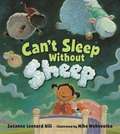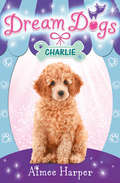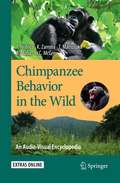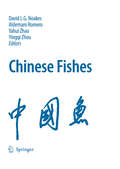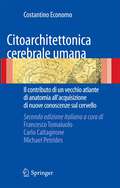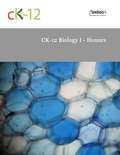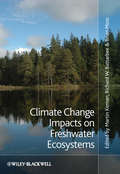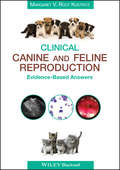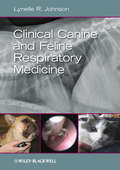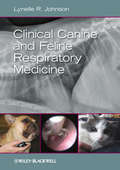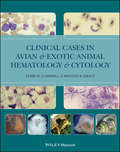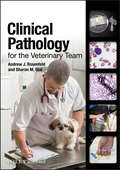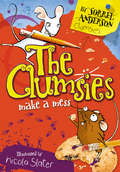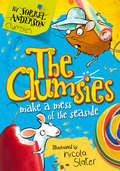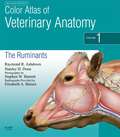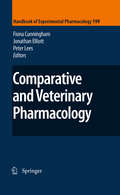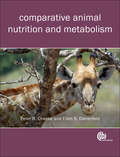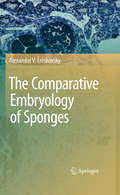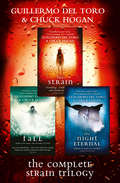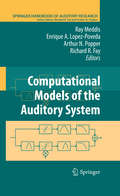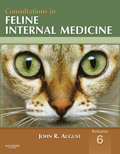- Table View
- List View
Can't Sleep Without Sheep
by Mike Wohnoutka Susanna Leonard HillWhenever Ava can't sleep, she counts sheep. But Ava takes so long to fall asleep, it's the sheep that are growing tired-until finally, they quit! When the sheep promise to find a replacement that Ava can count on, chaos ensues as chickens, cows, pigs, hippos, and more try their hand at jumping over Ava's fence. Finding the perfectly peaceful replacement for sheep might not be so easy after all.With irresistibly adorable art, this delightful take on a familiar sleep tactic is sure to become a bedtime favorite.
Charlie (Dream Dogs #5)
by Aimee HarperThe fifth exciting adventure from the gorgeous series set in a glamorous pooch parlour, for animal-crazy girls who love dogs and looking after them.
Chimpanzee Behavior in the Wild: An Audio-Visual Encyclopedia
by Toshisada Nishida Koichiro Zamma Agumi Inaba Takahisa Matsusaka William C. McGrewWhere We Stand Field workers—scientists of animal (including human!) behavior in nature—have long been fascinated by wild chimpanzees. A person who once has studied wild chimpanzees will be eager to observe them again. A person who has studied them twice will make every effort to continue the study, unless prevented from doing so. In short, behavioral primatology is addictive! Many people, among them Jane Goodall, Richard Wrangham, and I, do not regret that they have dedicated their whole lives to the study of wild chimpanzees. This is because the apes’ behavior is always challenging: chimpanzees are cheerful, charming, playful, curious, beautiful, easygoing, generous, tolerant, and trustw- thy most of the time, but also are cautious, cunning, ugly, violent, ferocious, blo- thirsty, greedy, and disloyal at other times. We human beings share both the light and dark sides with our closest living relatives. For decades, we have documented huge across-population variation in behavior, as well as within-population variation. Cultural biology (now called cultural pri- tology), as proposed 60 years ago by Kinji Imanishi, recently has flourished.
Chinese Fishes (Developments in Environmental Biology of Fishes #28)
by Yahui Zhao Yingqi Zhou David L. G. Noakes Aldemaro RomeroThis book documents the current state of research by Chinese scientists on fish biology and fisheries and brings together manuscripts by authors from research institutions, universities and government agencies. There are papers on aquaculture, life history, genetics, marine and freshwater biology, conservation, physiology, new species descriptions, and truly amazing hypogean fishes. The information on these remarkable cave species shows how much we have yet to learn from that incredible fauna. There are papers dealing with some of the largest fishes and some of the smallest cave species. There are papers dealing with some of the most traditional forms of aquaculture and others with the most modern molecular techniques. The volume includes papers on critically threatened native fishes as well as the most common food species, such as grass carp (Ctenopharyngodon idella). The information on rare and threatened species shows how China is dealing with their endangered fishes. The information on their carp species will be invaluable to those in other countries who will either take advantage of the productive carp species in aquaculture or try to manage them as invasive species outside China. For the first time we bring together a complete overview of the state of fisheries research in China.
Citoarchitettonica cerebrale umana: Il contributo di un vecchio atlante di anatomia all’acquisizione delle nuove conoscenze sul cervello.
by Francesco Tomaiuolo Carlo Caltagirone Michael PetridesNel 1925, Economo e Koskinas pubblicarono l’atlante più accurato e completo sulla citoarchitettonica della corteccia cerebrale umana mai realizzato. Una sintesi del contenuto dell'atlante venne in seguito resa disponibile in tedesco e tradotta in italiano, inglese e francese. Il valore scientifico di quest'opera è divenuto più significativo negli ultimi vent’anni con l'avvento delle tecniche di neuroimaging funzionale, le quali consentono persino di rilevare specifici focolai di attivazione nella corteccia cerebrale umana durante l’esecuzione di compiti cognitivi. Questa riedizione in italiano è stata ampliata rispetto all'originale con l'aggiunta della mappa dei solchi e dei giri del cervello. Inoltre, è stata inclusa la tabella delle corrispondenze tra le aree individuate da Economo e Koskinas e quelle descritte da Brodmann. Il volume sarà di grande interesse per tutti coloro che desiderano approfondire la relazione tra la struttura del cervello e le sue funzioni; rappresenterà inoltre un utile strumento di lavoro per i professionisti che utilizzano le neuroimmagini nella loro pratica quotidiana, quali neurofisiologi, neuropsicologi, neuroradiologi, neurologi e neurochirurghi.
CK-12 Biology I - Honors
by Ck-12 FoundationCK-12 Foundation's Biology 1- Honors FlexBook Covers the following chapters:<P><P> Foundations of Life Science- scientific investigations, methods, observations, & communication.<P> Chemical Basis of Life- matter, the significance of carbon, lipids, proteins.<P> Cell Structure and Function- prokaryotic, eukaryotic, plant, & animal cell features; structures / functions of DNA, RNA, protein, cell transport, homeostasis.<P> Photosynthesis- water, carbon, and nitrogen cycle between abiotic and biotic resources.<P> Cellular Respiration- relation to glycolysis, Krebs Cycle, electron transport chain.<P> Cell Division and Reproduction- cell division, reproduction.<P> Mendelian Genetics- inheritance, sex-linked traits.<P> Molecular Genetics- DNA, RNA, protein synthesis, mutation, regulating gene expression.<P> Human Genetics- human genome, diseases, Biotechnology- DNA technology, gene cloning.<P> History of Life- evolution, macroevolution, extinctions, episodic speciation, response to change.<P> Evolutionary Theory- Darwin's Theory of Evolution, common ancestry and natural selection.<P> Evolution in Populations- genetics of populations, genetic diseases, natural selection.<P> Classification- Taxonomy, scientific classification of organisms.<P> Principles of Ecology- Ecology's relation with energy; ecosystems, the water, carbon, and nitrogen cycles.<P> Biomes, Ecosystems and Communities- terrestrial/ aquatic biomes, community interactions.<P> Populations- Analysis of populations and dynamics.<P> Ecology and Human Actions- Balance between humans and the earth addressing natural resources, ecosystems, & biodiversity.<P> The Human Body- systems.<P> Nervous and Endocrine Systems- structures & functions, homeostasis.<P> Skeletal, Muscular, and Integumentary Systems- structures, functions, & homeostasis.<P> Circulatory and Respiratory Systems- structures and functions.<P> Digestive and Excretory Systems- structures/ functions, food pyramid.<P> Immune System and Disease- Body defenses against pathogens.<P> Reproductive System and Human Development- human reproductive systems, reproductive lifecycle, STDs.
Climate Change Impacts on Freshwater Ecosystems
by Martin Kernan Richard W. Battarbee Brian R. MossThis text examines the impact of climate change on freshwater ecosystems, past, present and future. It especially considers the interactions between climate change and other drivers of change including hydromorphological modification, nutrient loading, acid deposition and contamination by toxic substances using evidence from palaeolimnology, time-series analysis, space-for-time substitution, laboratory and field experiments and process modelling. The book evaluates these processes in relation to extreme events, seasonal changes in ecosystems, trends over decadal-scale time periods, mitigation strategies and ecosystem recovery. The book is also concerned with how aspects of hydrophysical, hydrochemical and ecological change can be used as early indicators of climate change in aquatic ecosystems and it addresses the implications of future climate change for freshwater ecosystem management at the catchment scale. This is an ideal book for the scientific research community, but is also accessible to Masters and senior undergraduate students.
Climate Change Impacts on Freshwater Ecosystems
by Martin KernanThis text examines the impact of climate change on freshwater ecosystems, past, present and future. It especially considers the interactions between climate change and other drivers of change including hydromorphological modification, nutrient loading, acid deposition and contamination by toxic substances using evidence from palaeolimnology, time-series analysis, space-for-time substitution, laboratory and field experiments and process modelling. The book evaluates these processes in relation to extreme events, seasonal changes in ecosystems, trends over decadal-scale time periods, mitigation strategies and ecosystem recovery. The book is also concerned with how aspects of hydrophysical, hydrochemical and ecological change can be used as early indicators of climate change in aquatic ecosystems and it addresses the implications of future climate change for freshwater ecosystem management at the catchment scale. This is an ideal book for the scientific research community, but is also accessible to Masters and senior undergraduate students.
Clinical Canine and Feline Reproduction: Evidence-Based Answers
by Margaret V. Root KustritzClinical Canine and Feline Reproduction: Evidence-Based Answers provides quick, reliable answers to the most common questions in canine and feline reproductive and pediatric practice. Written using an innovative question-and-answer format, each answer is designed for quick reference, with the best references listed for further information as needed. Based on the author’s years of experience answering questions on reproduction and pediatrics, Clinical Canine and Feline Reproduction allows the practicing veterinarian to rapidly find and apply evidence-based answers from the scientific literature to their clinical questions.
Clinical Canine and Feline Respiratory Medicine
by Lynelle R. JohnsonClinical Canine and Feline Respiratory Medicine provides reliable information on the diagnosis and management of respiratory disease in a user-friendly format. With an emphasis on the features of the history and physical examination that aid in efficient diagnostic planning, the book is an accessible, readable resource for optimizing treatment of patients with diseases of the respiratory tract. Offering comprehensive, accessible coverage of respiratory disorders, Clinical Canine and Feline Respiratory Medicine is a useful practice guide and study aid for general practitioners and veterinary students. Beginning with introductory chapters on the localization of disease, diagnostics, and therapeutics, the heart of the book focuses on the full range of respiratory diseases, including nasal disorders, diseases of airways, parenchymal diseases, pleural and mediastinal diseases, and vascular disorders. Each chapter takes a common format with diseases subdivided by etiology into structural, infectious, inflammatory, and neoplastic disorders. Clinical Canine and Feline Respiratory Medicine is a useful tool for students and practitioners engaged in studying, diagnosing, and treating respiratory disease.
Clinical Canine and Feline Respiratory Medicine
by Lynelle R. JohnsonClinical Canine and Feline Respiratory Medicine provides reliable information on the diagnosis and management of respiratory disease in a user-friendly format. With an emphasis on the features of the history and physical examination that aid in efficient diagnostic planning, the book is an accessible, readable resource for optimizing treatment of patients with diseases of the respiratory tract. Offering comprehensive, accessible coverage of respiratory disorders, Clinical Canine and Feline Respiratory Medicine is a useful practice guide and study aid for general practitioners and veterinary students. Beginning with introductory chapters on the localization of disease, diagnostics, and therapeutics, the heart of the book focuses on the full range of respiratory diseases, including nasal disorders, diseases of airways, parenchymal diseases, pleural and mediastinal diseases, and vascular disorders. Each chapter takes a common format with diseases subdivided by etiology into structural, infectious, inflammatory, and neoplastic disorders. Clinical Canine and Feline Respiratory Medicine is a useful tool for students and practitioners engaged in studying, diagnosing, and treating respiratory disease.
Clinical Cases in Avian and Exotic Animal Hematology and Cytology (Coursesmart Ser.)
by Terry Campbell Krystan R. GrantClinical Cases in Avian and Exotic Animal Hematology and Cytology demonstrates how to use hemic cytology and cytodiagnosis as part of the assessment of an exotic animal patient, taking the reader through nearly 100 actual clinical cases. With a focus on cytological interpretation, the hands-on, practical approach facilitates learning, teaching, and comprehension. Well illustrated throughout, Clinical Cases in Avian and Exotic Animal Hematology and Cytology is a helpful guide for exotics veterinarians, zoo and aquarium veterinarians, and veterinary hematologists.
Clinical Cases in Avian and Exotic Animal Hematology and Cytology
by Terry Campbell Krystan R. GrantClinical Cases in Avian and Exotic Animal Hematology and Cytology demonstrates how to use hemic cytology and cytodiagnosis as part of the assessment of an exotic animal patient, taking the reader through nearly 100 actual clinical cases. With a focus on cytological interpretation, the hands-on, practical approach facilitates learning, teaching, and comprehension. Well illustrated throughout, Clinical Cases in Avian and Exotic Animal Hematology and Cytology is a helpful guide for exotics veterinarians, zoo and aquarium veterinarians, and veterinary hematologists.
Clinical Pathology for the Veterinary Team
by Andrew J. Rosenfeld Sharon M. DialClinical Pathology for the Veterinary Team is a concise, reliable resource for technical team members performing clinical diagnostic evaluation. Focusing on sample handling, machinery calibration, normal physiology and anatomy, clinical diagnostics, and disease processes, the book helps technical team members to consistently achieve high-quality results in small animal lab work. An essential bench-side reference for in-house laboratories, the book includes a DVD with interactive cases to build skills in reading and interpreting digital slides. With chapters on blood counts, chemistry, urinalysis and electrolytes, advanced diagnostics, and cytology, Clinical Pathology for the Veterinary Team offers key technical information for consistently obtaining and evaluating samples. The book is a practical resource for anyone performing lab work, including veterinary technicians, technician and veterinary students, and veterinarians.
Clinical Pathology for the Veterinary Team
by Andrew J. Rosenfeld Sharon M. DialClinical Pathology for the Veterinary Team is a concise, reliable resource for technical team members performing clinical diagnostic evaluation. Focusing on sample handling, machinery calibration, normal physiology and anatomy, clinical diagnostics, and disease processes, the book helps technical team members to consistently achieve high-quality results in small animal lab work. An essential bench-side reference for in-house laboratories, the book includes a DVD with interactive cases to build skills in reading and interpreting digital slides. With chapters on blood counts, chemistry, urinalysis and electrolytes, advanced diagnostics, and cytology, Clinical Pathology for the Veterinary Team offers key technical information for consistently obtaining and evaluating samples. The book is a practical resource for anyone performing lab work, including veterinary technicians, technician and veterinary students, and veterinarians.
The Clumsies Make A Mess: Make A Mess; Make A Mess Of The Seaside; Make A Mess Of The Big Show (The Clumsies #1)
by Sorrel AndersonThree crazy, funny stories, featuring the two clumsiest talking mice you’ll ever meet…
The Clumsies Make a Mess of the Seaside: Make A Mess; Make A Mess Of The Seaside; Make A Mess Of The Big Show (The Clumsies #2)
by Sorrel AndersonMore hilarious stories about the two clumsiest talking mice you’ll ever meet…
Color Atlas of Veterinary Anatomy, Volume 1, The Ruminants E-Book
by Raymond R. Ashdown Stanley H. Done Stephen W. BarnettThe Color Atlas of Veterinary Anatomy volume 1 presents a unique photographic record of dissections showing the topographical anatomy of the ruminant. With this book you will be able to see the position and relationships of the bones, muscles, nerves, blood vessels and viscera that go to make up each region of the body and each organ system. Each book in this three volume series is packed with full-color photographs and drawings of dissections prepared specifically for these texts.Accessibly and systematically structured with each chapter devoted to a specific body region.Important features of regional and topographical anatomy presented using full-color photos of detailed dissections.Detailed color line drawings clarify the relationships of relevant structures.Presents anatomy in a clinical context.Accompanying website with interactive quizzes and the chance to test yourself with self-assessment questions.New chapter on radiological anatomy.Special notes highlight clinical significance of each section.
Comparative and Veterinary Pharmacology (Handbook of Experimental Pharmacology #199)
by Fiona Cunningham Jonathan Elliott Peter LeesThe human–animal bond has evolved and diversi?ed down the ages. Dogs, cats and even horses, have long ful?lled the role of faithful companion and indeed, as exempli?ed by the introduction of seeing and hearing dogs, there may be a critical level of co-dependency between the species. In the twenty-?rst century, the animal types that are kept as pets in many parts of the world are extensive ranging from reptiles through rodents to ruminants and beyond. As would be predicted by the nature of the relationship, the approach to treatment of a companion animal is often closely aligned to that which would have been offered to their owner. However, an increasing awareness of welfare issues, such as the recognition that animals expe- ence pain and the proven bene?ts of disease prevention in intensive farming units, together with the growth in zoos and wildlife parks, has increased the likelihood of food producing and non-domesticated animals receiving medicinal products during their life-time. Although many of the individual drugs or classes of drugs administered to animals are the same as, or derived from, those given to man, the safe and effective use of drugs in animals often cannot be achieved by simply transposing knowledge of drug action on, or behaviour in, the body from one species to another. The impact of the anatomical, physiological and pathophysiological variability that spans the animal kingdom can often profoundly alter drug response.
Comparative Animal Nutrition and Metabolism
by Peter Cheeke Ellen DierenfeldNutrition is a very broad discipline, encompassing biochemistry, physiology, endocrinology, immunology, microbiology and pathology. Presenting the major principles of nutrition of both domestic and wild animals, this book takes a comparative approach, recognising that there are considerable differences in nutrient digestion, metabolism and requirements among various mammalian and avian species. Explaining species differences in food selection, food-seeking and digestive strategies and their significance to nutritional needs, chapters cover a broad range of topics including digestive physiology, metabolic disorders and specific nutrients such as carbohydrates proteins and lipids, with particular attention being paid to nutritional and metabolic idiosyncrasies. It is an essential text for students of animal and veterinary sciences.
Comparative Animal Nutrition and Metabolism (PDF)
by Peter Cheeke Ellen DierenfeldNutrition is a very broad discipline, encompassing biochemistry, physiology, endocrinology, immunology, microbiology and pathology. Presenting the major principles of nutrition of both domestic and wild animals, this book takes a comparative approach, recognising that there are considerable differences in nutrient digestion, metabolism and requirements among various mammalian and avian species. Explaining species differences in food selection, food-seeking and digestive strategies and their significance to nutritional needs, chapters cover a broad range of topics including digestive physiology, metabolic disorders and specific nutrients such as carbohydrates proteins and lipids, with particular attention being paid to nutritional and metabolic idiosyncrasies. It is an essential text for students of animal and veterinary sciences.
The Comparative Embryology of Sponges
by Alexander V. EreskovskyOne of the major questions in the evolution of animals is the transition from unicellular to multicellular organization, which resulted in the emergence of Metazoa through a hypothetical Urmetazoa. The Comparative Embryology of Sponges contains abundant original and literary data on comparative embryology and morphology of the Porifera (Sponges), a group of 'lower Metazoa'. On the basis of this material, original typization of the development of Sponges is given and the problems concerning origin and evolution of Porifera and their ontogenesis are discussed. A morphogenetic interpretation of the body plan development during embryogenesis, metamorphosis and asexual reproduction in Sponges is proposed. Special attention is given to the analysis of characteristic features of the ontogenesis in Porifera. The book pursues three primary goals: 1) generalization of all existing information on individual development of sponges, its classification and a statement according to taxonomical structure of Porifera; 2) revealing of heterogeneity of morphogenesis and peculiarities of ontogeneses in various clades of Porifera, and also their correlations with the organization, both adult sponges, and their larvae; 3) revealing homology of morphogeneses in both Porifera and Eumetazoa, testifying to the general evolutionary roots of multicellular animals, and peculiar features of sponges' morphogeneses and ontogenesis. This book will be of interest to embryologists, zoologists, morphologists and researchers in evolutionary biology.
The Complete Strain Trilogy: The Strain, The Fall, The Night Eternal (The\strain Trilogy Ser. #1)
by Guillermo del ToroHigh-concept thrillers with a supernatural edge from world-famous director, whose films include Pan’s Labyrinth and Hellboy. Now a popular Amazon TV Show.
Computational Models of the Auditory System (Springer Handbook of Auditory Research #35)
by Ray Meddis Enrique A. A. Lopez-Poveda Richard R. R. Fay Arthur N. N. PopperThe Springer Handbook of Auditory Research presents a series of comprehensive and synthetic reviews of the fundamental topics in modern auditory research. The v- umes are aimed at all individuals with interests in hearing research including advanced graduate students, post-doctoral researchers, and clinical investigators. The volumes are intended to introduce new investigators to important aspects of hearing science and to help established investigators to better understand the fundamental theories and data in fields of hearing that they may not normally follow closely. Each volume presents a particular topic comprehensively, and each serves as a synthetic overview and guide to the literature. As such, the chapters present neither exhaustive data reviews nor original research that has not yet appeared in pe- reviewed journals. The volumes focus on topics that have developed a solid data and conceptual foundation rather than on those for which a literature is only beg- ning to develop. New research areas will be covered on a timely basis in the series as they begin to mature.
Consultations in Feline Internal Medicine, Volume 6 - E-Book
by John R. AugustCompletely revised and updated with 80 all-new chapters covering the most important information on current diagnostic, treatment, and preventive challenges facing feline practitioners today, Consultations in Feline Internal Medicine is an invaluable addition to every small animal clinician’s library. Full-color illustrations and expert contributions help you master and apply the latest advances in feline nutrition, emerging diseases, pet overpopulation, advanced imaging, and more with a comprehensive, clinically relevant approach. More than 100 worldwide leaders in small animal practice provide expert insight across the full spectrum of feline internal medicine. Extensive references make it easy to find additional information about specific topics most important to your practice. Current, evidence-based coverage reflects the latest findings and reports on pressing topics such as: Upper Respiratory Tract Aspergillosis Exocrine Pancreatic Insufficiency Diagnostic Imaging of the Ear Cardiac Blood Tests Urological Interventional Techniques A new section on feline nutrition highlights the impact of nutritional considerations on feline health. A dynamic full-color design, incorporating hundreds of NEW illustrations and tables, clarifies concepts and helps you interpret clinical data.
